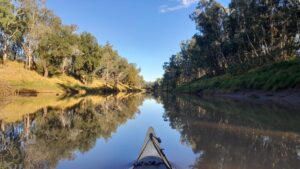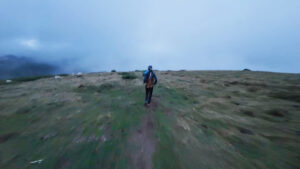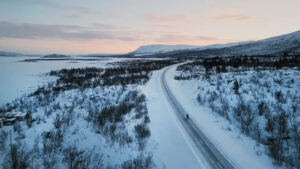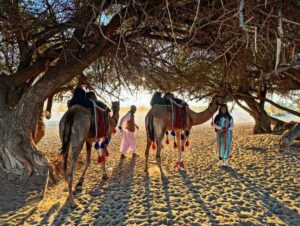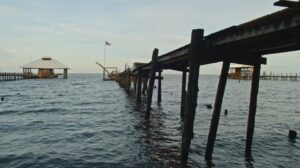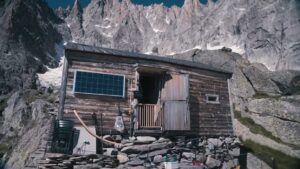In 2015, Canadian filmmaker Dianne Whelan set off on the Great Trail, which combines 487 different trails and multiple waterways into the longest trail in the world. Five-and-a-half years later, she is still hiking, snowshoeing and paddling her way across Canada. When she reaches the end of the trail at Victoria, B.C,, she will become the first person to complete it.
One man has previously done all the hiking sections, but no one else has attempted to include all the waterways as well. She has been filming her journey and will meld the footage into a feature film entitled 500 Days in the Wild.
ExplorersWeb spoke to her about her journey.
This is a huge undertaking. Have you done anything like it before?
Yeah, this was rather ambitious. Adventure and the outdoors has always been a part of my life. When I was five years old, my parents moved to British Columbia and we lived right on the edge of a rainforest. I was out there with tadpoles and frogs and salamanders, and I always felt a sense of belonging in nature. It was a place where everything made sense to me.
Later, I rode my mountain bike down to Baja California a few times and hiked the Pacific Crest Trail. So I had done adventurous things. But I’ve also filmed world-class athletes and I definitely don’t myself in that category.
The Great Trail is about 24,000km long, including 8,000km of paddling, so I’ve never done anything like this. But I also think that I bring a different sensibility to this journey than most people. I’m not trying to conquer or prove anything. I’m out here as an artist to make a film and write a book. So the journey is not being measured by how fast or how hard I go. It’s all about connection, connection to myself, connection to the physical environment that I travel through and connection to the people I meet. I spend a lot of time in indigenous communities in Canada to learn more about different mind-sets.
If you think about the songlines of aboriginal people and migration patterns of animals, this idea of journeying is very, very old.

The Great Trail (green = land, blue = water). Image: Dianne Whelan
When you first came up with the idea of doing this, was it driven by your artistic side or did you want to do it for yourself and then realize that it would make a great film?
It’s kind of like what came first, the chicken or the egg. On one level, doing this trail fit in with my need for a new film project. I was definitely conceptualizing the project as both something I wanted to do both personally and for a film. When I make a film, I don’t just visit my subject occasionally, I put myself in the experience. For instance, at Everest Base Camp, I wanted to make a film about a climbing season and to follow many different people. So I lived there for 40 days. When I went up to the Arctic and I shot This Land, I did the same thing: I traveled [by snowmobile] with seven men, including four Inuit elders, and I became a part of their team in order to film it. So fully infiltrating the experience is very much my way of making things. I suppose what makes this one different is that this time, I’m both the observer and the observed.
It’s about searching for meaning in your life, but also searching for meaning in your culture. Because I have that intention, I’ve been welcomed into most First Nations communities.
Did these communities give you any advice?
The grand chief of the Mi’kmaq people gave me one of the greatest pieces of advice. I really believe it has kept me safe on my journey. He said that I thought I was traveling the old way because I was canoeing, snowshoeing and walking. But he said that traveling the old way isn’t about going without motors. It’s about what you carry in your heart as you travel. “With every step in the forest, you should say that the earth is sacred,” he told me. “And on the water, you should say the water is sacred. That’s the old way.”
As a woman, I was filled with fear about this journey because I’m camping by myself. So whenever I got into a place of fear, and that still happens now, I start doing these mantras. Not only has it shifted my connection to the environment, but I’ve been safe: I haven’t hurt myself, I haven’t been ill and I’ve been out here a long time.

Ice forming on Lake Superior. Photo: Dianne Whelan
Over the five years, have you been traveling continuously or have you gone home now and then?
For the first three years, I tried to go all winter. Then once I was paddling between Thunder Bay, Ontario and Whiteshell Provincial Park in Manitoba. It was late October, and a friend had joined me for a couple of weeks when a snowstorm hit. All the trees in the forest started collapsing because they were heavily weighted down with wet snow that froze. And the water I was paddling on froze overnight. We were in a predicament because we were very, very, isolated.
We set up a base camp and started bushwhacking and cutting a new trail. Luckily, we had a satellite phone and were able to reach my cousins, who drove eight hours and started working from the other end. Even so, it took about a week before we could extract ourselves.
After that, a Cree grandmother whom I had met earlier, who had heard about us on the news, wrote to me and said, “You want to learn the old way? Well, we didn’t travel in the winter. That was story time and community time in camp.”
So that winter, I took nine weeks off before I returned. And then last winter, my mother had a medical emergency. So there have been a couple of winters now when I’ve taken a break.
I’ve also come off the trail sometimes to do speaking gigs when the opportunity presents itself. It’s one of the ways that I finance myself out here. I also have a site where people can donate.
Do you see your partner or your parents at all?
I didn’t see much of my family for the first couple of years. But indigenous elders often said to me, “We’re glad that you’re paying your respects to us, but don’t forget your own elders.”
So I’ve tried to balance that more. With my mom’s health issues last Christmas, the importance of seeing people really hit home. I’m up to 16 people who have died since I began this journey, which includes cousins, aunts and uncles and friends. So life doesn’t wait when you embark on these journeys. You can’t expect to come home to the same world you left, and it’s not just because the journeys change you.
When I came back from Everest, I’d been with my wife for 13 years, but my marriage ended as soon as I came home because I’d become a different person. We return home from these journeys and maybe the people we left are different and maybe we’re different. It’s one of the casualties of the trail.
I’m still spending about 90 per cent of my life out here without family and friends. Recently my partner has been supporting me a lot, and this partnership began since I’ve been trekking. When COVID hit, she came out in a support vehicle so that I could resupply without going into any communities. I still do most of the trail alone, but I have a lot more support this year than I’ve ever had.

Photo: Dianne Whelan
How long did you initially think this journey would take?
I was more of a Type A personality when I started. I had an itinerary and I had goals and I was going to try to go 50km a day through Newfoundland. On day 10, I realized that I hadn’t even put in one day’s distance yet. At that point, all of my plans went up in smoke. And I thought, this is where we take off the rabbit tail and we put on the turtle shell, because if you’re out here looking at your watch and panicking that you’re behind schedule, you are not going to enjoy yourself.
I also I knew that I needed to do that in order to survive. So if I’m paddling a canoe alone on Lake Superior, if there’s wind and waves on the water, I’m not going anywhere because it suits my schedule. Sometimes I’ve had to wait a week. People get into danger when they say, “Ok, I’m going to cross Antarctica, and I’ve got a month to do it because then I’ve got to get back to work.”
Why do you think you’re the only person who has done both the paddling and hiking sections of this trail?
The trail was always conceptualized as both a land trail and a water trail. Other hikers choose to just walk roads in the sections where I paddle. I can understand why: It’s logistically difficult to shift between canoeing and hiking, because the paddles are separated by thousands of kilometres.
Some of the paddling sections I lengthened because I needed to reroute around dangerous waters. I’ve also added a couple of hundred extra kilometres of water trails. One section of land was washed out, but it happened to be right beside Lesser Slave Lake. So I paddled 200km this summer along a route that was marked on the map as a land trail.

The remainder of Whelan’s route (red = land, yellow = water). Image: Dianne Whelan
How far do you have left?
About 1,400km, and I’m going into winter now, so I’ll be slow again. I’ll be back on skis and snowshoes soon, and it’s slower when I’m snowshoeing.
You’ve mentioned all these different ways you’ve traveled — hiking, snowshoeing, skiing, canoeing. Do you have a favorite?
Yes, the canoe is my favorite. I tell everybody that when I’ve finished this journey, I may not take long hikes any more, but I’ll definitely continue doing long canoe excursions. Last summer, paddling for five months up to the Arctic Ocean, I never saw another canoeist or kayaker. It was absolutely amazing. As a filmmaker, you can get really close to the animals without being threatening to them, because you’re in a boat floating on the water.
Was all this new to you when you started?
It was quite new. I’d paddled but never like this; never solo, for example. So all of a sudden, my first paddle was a 40-day solo. And there have been some massively long stretches, like Lake Superior and the 4,000km paddle to the Arctic Ocean last summer.
Which sections have you most enjoyed, and which have been the hardest?
The paddles have been my favorite part. Those have been the most remote and they are the parts that have changed me the most. Of the land trials, I would say the Voyager Trail near Lake Huron was definitely one of the hardest sections. I was going about four kilometres a day, and it was hard work. I had a little ax, and there were all these fallen trees, and I had to chop off branches and drag my gear underneath. It was very slow and also about -29°C.
Have you done all the filming yourself?
I did much of the camera work for both my other films but I also hire other cinematographers. As a camerawoman, I’m very intuitive but not very technical. So when I hire a cameraperson, it’s always someone who’s the opposite of me. Combining the intuitive with the technical gives my films the aesthetic that I want them to have.
Here again, I am the primary cinematographer. Another filmmaker named Ann Verrall, who is a producer on this project, has also done a lot of filming. I’ve also brought in a few drone guys for short periods. There are about eight or nine others whose content will be woven into the film.
In the time I’ve been out here, the only people who have joined me on the trail have been women, except for one man. Women are making the film. I’m the director and producer. It has two other women producers, and we’re about to bring on a woman editor. The soundtrack is going to be all women. And that is going to make it very different as well.

Lesser Slave Lake. Photo: Dianne Whelan
Filming must affect how much you have to carry.
Everything has been filmed in 4K, so the footage will be beautiful and very high quality. I carry four different cameras. Right now, with a support vehicle, I’m able to plot much shorter stints, so I do not have to carry as much. Soon, when it starts to snow and I’m skiing or snowshoeing, I’ll pull a sled and will have to carry more gear again.
To film, I mainly use my GoPro, a larger 35mm Panasonic DSLR with an assortment of lenses and a gimbal camera from DJI, so that I can film smoothly without a tripod. After five years, I have 400 hours of footage. In addition to making this independent feature, I’ve also filmed three TV half-hours, in collaboration with indigenous women, which highlight that part of the journey.
What pieces of kit couldn’t you have done without?
I carry a SPOT tracker, and being able to press a button to alert search and rescue has been pretty imperative. I always have paper map because I don’t want to rely solely on a digital device that could stop working. I also use an app for The Great Trail that always shows your position on a satellite map. Having both paper and digital has been very valuable because this brand new trail is often not marked, apart from the occasional sign. Sometimes, it is clear that whoever came up with a particular section did not hike it themselves, because some parts have never been used. They barely exist.
I have basic survival tools on my body at all times: a Swiss Army knife and a few ways to make fire. I always carry a little bag with dried birch bark and some sap, so that I can start a fire, even if I get separated from my gear. But I’m very happy to say that in more than five years, I have never had to ask search and rescue for help. I also have a satellite phone, which again, is imperative because usually a cell phone doesn’t work.
The other thing that I was advised to do — I would not have thought of it on my own — is always to wear dry suit when paddling, even in summer.

Campfire and candle lantern: two ingredients of a cozy winter camp. Photo: Dianne Whelan
Do you carry a gun for protection from bears?
Not until I went to the Arctic last year. Before that, I only carried bear spray, but my partner convinced me to get a firearms license. My partner Louisa and I took the course, and halfway through the paddle to the Arctic, we received our licenses. She had joined me on that section, so we had a gun for the last 2,000km.
A week after the gun arrived, I heard about a guy from France, who was ahead of me on the river by one week. A grizzly hauled him out of his tent in the middle of the night and ate him. Frightening. At that point, I was happy to have the gun. Sure enough, after two weeks, a bear came into camp. We fired two warning shots and the bear stopped.
Will you continue carrying a gun?
I brought the gun on one other remote paddle. I was on Lesser Slave Lake, and when I woke up, the tent was about an inch from my face. A bear had put its paw on top of it. So I opened the door. This bear wasn’t aggressive, it was a two-year-old black bear, three to four hundred pounds. It clearly was very shocked to find a person inside and just ran away. In this case, I didn’t need the gun, but other times, a gun is the only thing that will save you.
Before this journey, I would never have carried a gun for any reason. I believed that if I carried one, it would bring negative experience to me, but the journey north made me realize that there was a certain amount of naiveté in that.
Where did where did you start and where will you end?
I started in St. John’s, Newfoundland, on the east coast of Canada, where my father was born. I liked the idea of following the sun back home. The trail ends for me in Victoria, British Columbia. I love this direction for lots of reasons, but admittedly I have had a headwind the entire way.
For the last 500km, I’m going to paddle the Salish Sea and the Fraser River. That’s the end of the trail.
On your website, you call this a solo journey. But for parts of it, your photos show that you’ve traveled at least occasionally with other people. Would you still consider it a solo?
When I started, it was definitely solo. I was alone and didn’t want anybody with me. What the last five-and-a-half years have taught me is that there is no such thing as solo. In Western culture, we tend to romanticize the rugged, self-sufficient individual. But as I mentioned to you, part of this journey has been learning a different mind-set. I started this journey romanticizing my individualism, my independence, being a woman and thinking I can do this alone. Now I realize how broken I must have been to think that.

Photo: Dianne Whelan

